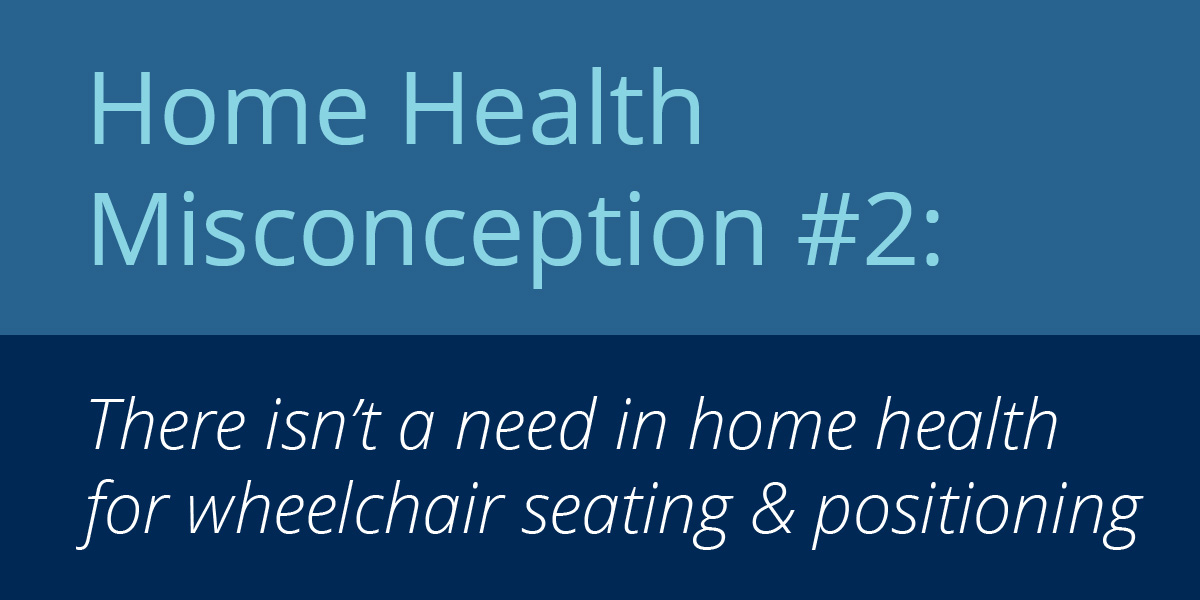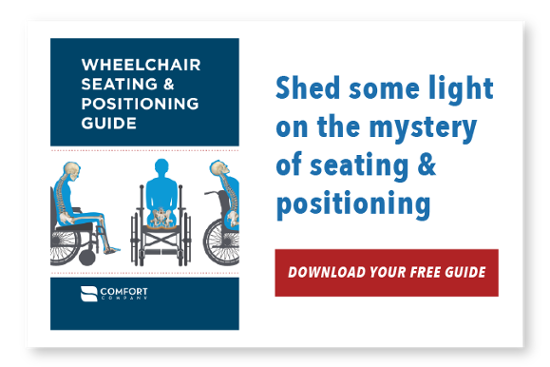Part 3 in our series about Seating & Wheeled Mobility in Home Health. See Part 1 and Part 2.
We’re continuing to look at common misconceptions of seating and wheeled mobility in the home health setting. Last week we took a look at the misconception that someone else will deal with seating and wheeled mobility in the home health setting. This week we will discuss whether home health therapists are seeing clients who would benefit from appropriate seating and wheeled mobility services. This will help us determine whether this area of practice is relevant to the home health setting.
Misconception #2: There isn’t a need in home health for wheelchair seating and positioning
As therapists we sometimes feel that providing a wheelchair is a failure on our part. Often, our goal is to get clients ambulatory, but remember the ultimate goal is always to provide optimal independence and function. We must ask questions like: is that ambulation actually functional? Can the client do all the things they need to do in their home throughout the day over a 24-hour period using that means of mobility? Or is there another tool that we could provide them as something that they can utilize to be more independent and functional? I think once your eyes are opened to what proper seating and wheeled mobility can, you’ll find that you probably have many clients who would benefit.
Let’s look at some possible indications and scenarios for wheelchair use:
Non-Ambulatory: A client who is non-ambulatory would be an indication for wheelchair use, either independently or with help from a caregiver. An appropriate wheelchair system could allow increased participation in activities of daily living (ADL’s) and improved quality of life.
Fall Risk: How about a client who has decreased safety with ambulation and is at risk for falls? Ask about the history of falls and be sure to perform an objective balance assessment such as a BERG or a DGI, something to really objectively display the fall risk. If the tests indicate a fall risk, an appropriate wheelchair system can provide them with a safe mobility solution that can promote increased independence with ADL’s.
Assist with Ambulation: How about someone who requires assistance for ambulation within the home and wheeled mobility would allow independence? Or someone who requires increased time for ambulation within the home? This is where you can perform a gait speed test. Think about whether the client can make it to the restroom without experiencing urge incontinence and ask yourself would a wheelchair allow them to get to the restroom in time?
Poor Endurance: Think of clients who are unable to consistently ambulate throughout the day in the home. Consider a 24-hour period, is the client fatigued? Do they have issues with oxygen saturations dropping too low or heart rate increasing above a safe range? An appropriate wheelchair system can allow these clients to engage in more activities throughout the day and increase independence and quality of life.
Prolonged Sitting: Clients who sit all day are at risk of developing pressure injuries. Simply adding a cushion to a recliner will often not alleviate this risk since most cushions do not fit a recliner and should primarily fit the person. This is where an appropriate wheelchair and seating system can decrease the risk of pressure injury and increase the client’s engagement with their environment. These clients are also more likely to develop abnormal postures if not well supported. Abnormal postures can then contribute to health issues like decreased respirations, difficulty swallowing, UTI’s, and digestive problems. An appropriate wheelchair seating system can minimize the progression of abnormal postures and promote increased function and independence. Consider whether these clients could perform their activities of daily living from a seated posture in the customary location in the home. For example, would an appropriate wheelchair allow them to perform toileting in the bathroom rather than at a bedside commode in the living room?
To summarize what was stated above here is a quick bullet list of possible indications and scenarios for wheelchair use:
- A non-ambulatory client
- A client at risk for falls
- A client who requires assistance for ambulation within the home
- A client who requires increased time for ambulation within the home
- A client who is unable to consistently ambulate throughout the day
- A client who is unable to perform activities of daily living while standing
- A client who has issues with oxygen saturations dropping too low
Let’s be honest, this list represents many clients that we see in home health! Instead of thinking of wheeled mobility as a setback, think of it as a way to help clients remain independent within their own homes. And once you start looking at your clients through this lens, you’ll find that many clients will benefit from different types of mobility, not just ambulation.
Join us next week as we take a look at the last misconception that we are going to examine in the home health setting: we can't bill for that.
 Stacey Mullis, OTR/ATP
Stacey Mullis, OTR/ATP
Director of Clinical Marketing
Stacey serves as Director of Clinical Marketing for Permobil. A practicing OTR for over 20 years, she has experience in school-based pediatrics, inpatient rehabilitation, long term care, and home health. With her interest in wheelchair seating and positioning, Stacey engaged the challenges of providing appropriate seating in various clinical settings. She now uses this experience to develop programs and resources to educate clinicians on the principles of seating and wheeled mobility. She is passionate about equipping clinicians and through her previous role as Director of Clinical Education with Comfort Company and now with Permobil she has taught nationally and internationally to increase therapist capacity in this specialty area. Mullis graduated from Western University in London, Ontario, Canada with a BA Linguistics and BSc Occupational Therapy. She is a member of the NCOTA, CTF Executive Board, NRRTs, RESNA, and AOTA.

